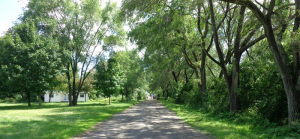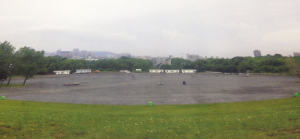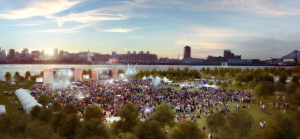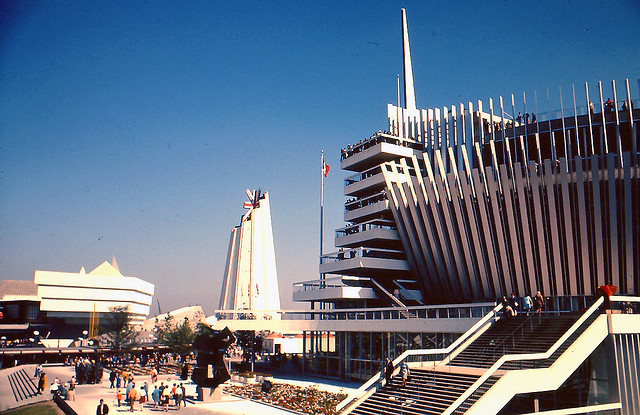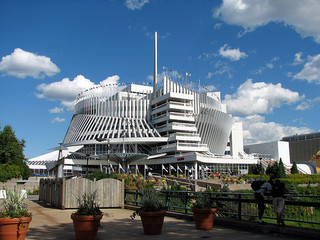
A view of the Expo site during the fair. Uploaded by DJ Berson on Flickr. Available under Creative Commons License.
Written by Brian Byrd, Michael Catsos, Daniel Mckenna-Foster, and Isaac Robb.
Expo ’67 represented the centerpiece of Canada’s celebrations surrounding the nation’s centennial. Awarded permission to hold the fair by the Bureau International des Expositions (BIE) in 1962, the fair’s planners set out to create an event celebrating the world created by men and women of all nationalities.
Given the short time between Montreal’s approval by the BIE and the fair’s opening date five years later, many of the developments that led to the creation of the site are especially impressive. First, the Expo took place primarily on two islands that were essentially purpose-built for the fair. Over the course of ten months, material excavated during the construction of the Montreal Metro was dumped strategically in the Saint Lawrence River to enlarge the existing Ile Sainte-Helene and create the new Ile Notre-Dame.[1] A third portion of the site, Cite du Havre, was also enlarged using this process. The artificial islands were surrounded by nearly five miles of new retaining walls.
Second, extensive transportation developments were implemented to improve access to the site. The 2200-foot Concordia Bridge was built to expand access to the new islands. The Montreal Metro, which played a major role in the construction of the islands, also served the islands during the fair, and was completed less than a year before the Expo began.[2] The site featured both the Expo Express, a mass transit system serving only the Expo islands and the Minirail, an automated monorail that also served the site. While the Expo Express and the Minirail have since been removed, the highway bridges and the Metro still play a significant role for site access today.
During the fair, the Expo site played host to more than 90 pavilions representing different nations and themes.[3] Ile Sainte-Helene, at the center of the site, contained a large park area with an extensive network of pedestrian footpaths. On the same island, the La Ronde section of the site held more than 130 acres of rides and amusements. Both of the newly created islands also contained lakes, and Ile Notre-Dame’s pavilions were clustered around a system of narrow canals. Many of the original pavilion sites were converted into a 2.2 kilometer Olympic basin for the 1976 summer Olympic Games.[4]
The history of this site is unique in several respects. Most noticeably, compared with other World’s Fair sites of the era, this location had far less of a human imprint prior to the fair, since the islands that hosted it were not in existence prior to the development of the fair. The isolated location of the site, which is separated by water from existing neighborhoods nearby, compounds the sense of the site as a distinct area without a prior landscape history.
The Expo’s place on the Montreal periphery has also guaranteed that downtown development activities have had less of an influence on the physical development of the site. Both during and after the fair, this relationship had an influence on transportation connectivity and environmental planning at the Expo site, including limiting the types of redevelopment activity that have been considered feasible in the decades since the fair concluded.
Present Conditions
In 1999-2000, the 1967 expo site was renamed Parc Jean Drapeau in honor of the mayor who originally brought the world’s fair to Montreal. The park land belongs to the City of Montreal but is managed by Société du parc Jean-Drapeau, a para municipal organization established by the Charte de la Ville de Montréal.[5] The Société du parc Jean-Drapeau report materials state:
The mission of the Société is to manage, administrate, operate, develop, maintain and animate Parc Jean-Drapeau…the Société is responsible for developing tourist and recreational activities on a regional as well as international scale.
In its Guiding Plan, the Société has determined the following priority strategic orientations of its development:
– Unify the site, from both an identity and spatial standpoint;
– Encourage the use of modes of transportation other than car travel;
– Preserve and publicize the natural heritage;
– Preserve and publicize the cultural heritage;
– Encourage users to take advantage of and visit the Parc;
– Recognize the Parc’s sporting heritage and encourage the practice of physical and outdoor activities;
– Manage the Parc in compliance with the objectives set down in the revised Guiding Plan from a sustainable development standpoint.[6]
In 2012 the park had 11 million visitors, 25 km of cycling paths, and 8 indoor and outdoor rental sites for corporate events, weddings, and other activities.[7] The park generates revenue through visitors to the beach and aquatic complex, rental of original buildings such as the Jamaican pavilion for weddings or corporate events, and larger scale events such as concerts and grand prix racing. It can be reached by two bridges connected to downtown Montreal as well as a subway station on the city’s yellow line.
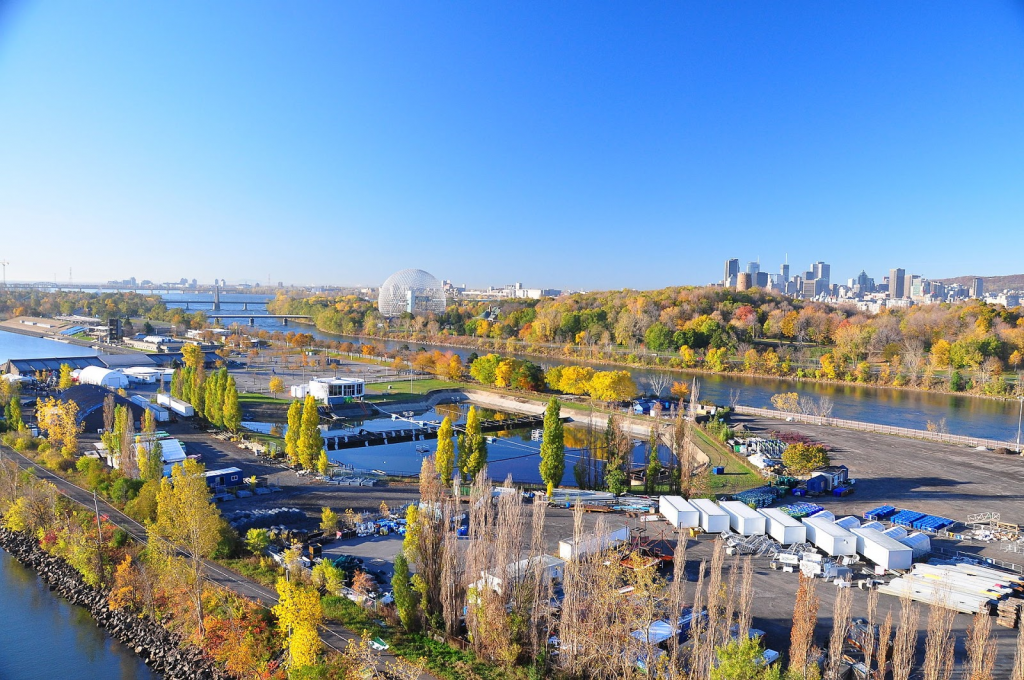
The site today. In the foreground is Ile Notre Dame. In the background is Ile Saint Helene, the Biosphere, and the Montreal skyline. Parc Jean Drapeau et Montreal. User abdallahh. Wikimedia Commons.[8]
Since 2009 the park has used an offset fund called the Fonds Oxygène to purchase market rate greenhouse emissions credits. The fund levies an additional $1 on top of parking fees and a 2-3% charge on costs for event holders such as the GRANDPRIX. Event holders may have this fee reduced if their event materials promote visiting the site in a sustainable manner such as by using public transit.[11]
Existing Plans and Proposal
The Societe du Parc Jean-Drapeau has worked to develop a number of plans for the future of the site in the last several years. To correspond with the 50th anniversary of the Expo and the 375th anniversary of the City of Montreal the Horizon 2017 plan was drafted to schedule new infrastructure investments and identify opportunities to rehabilitate historic structures.[12] The government of Quebec plans to invest more than $35 million in the site on projects to upgrade sports facilities and protect the natural and historic heritage of the location; one notable early priority is the restoration of the Place des Nations, which hosted the Expo’s opening events and now serves as a site for vehicle and equipment storage.
Ongoing, regular developments are guided by a number of different policies, including a Sustainable Development Policy adopted by park leadership in 2009.[13] The Sustainable Development Policy centers around six core principles for the park and park management: quality of life and health, sustainable economic growth, environmental protection, heritage protection and preservation, responsible partnerships, and respect for ecosystems. The policy then identifies several dozen objectives derived from the core principles intended to improve the future of the park, including ecosystem protection, creation of sustainable wealth sources, balance between different park uses, enhancement and rehabilitation of historically significant athletic and cultural monuments, and development of sustainable management practices. Recent yearly budgets have included funds to preserve certain structures, rehabilitate other deteriorating buildings, and upgrade signage around the site. The site’s water, power supply, and sewer infrastructure, intended to be temporary, has served the islands for more than 40 years, and reviews of park facilities have identified these systems as a spending priority.[14]
Sustainability Initiatives & Issues
Parc Jean Drapeau faces a number of sustainability challenges related to environmental functionality, social equality and engagement, economic stability, and historic preservation. From an environmental perspective, park administrators have expressed concerns in the past about the lack of a recycling program on the island, carbon emissions from visitors to park events who arrive in personal vehicles, and the application of chemicals as a part of routine landscaping procedures. Reports prepared by the Societe reflecting on overall park health and functionality have noted that transit access to the park becomes difficult during crowded major events[15]. Park administrators have also identified external environmental threats, such as the risk of invasive aquatic species being introduced into the park’s lakes and lagoons during boating events.
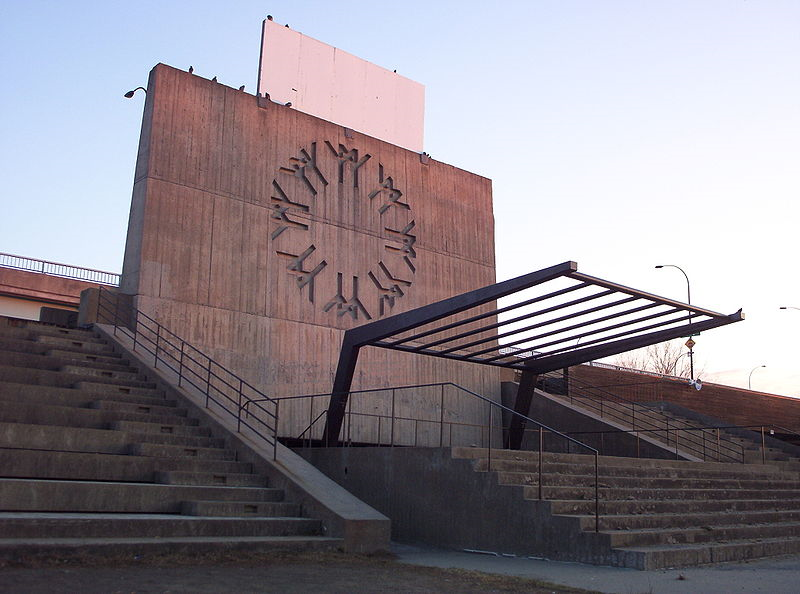
The Place des Nations, a signature venue of the Expo, has fallen into disrepair and been used as a storage area for vehicles and equipment. Place des Nations – Montreal. User Colocho. Wikimeda Commons.
From a social perspective, park planners have expressed concerns about the unclear constituency that supports the park. They have expressed a desire to strengthen the public’s sense of “ownership” over the park and future goals for the space. Still, the relative isolation of the park and the lack of a history of community involvement in the space prior to the world’s fair continues to present a major obstacle. More so than many other sites of this variety, Parc Jean Drapeau remains largely a special event space in the collective consciousness of Montreal.
While the park’s economic situation is relatively stable compared to many of the other world’s fair sites, management of the park has faced declining annual contributions from the City of Montreal towards park operations. A recent spending push and initiatives to restore facilities may offset some of the impact of this trend, however[17].
Additional challenges face efforts to preserve the historic remnants of the ‘67 fair. Audits conducted by the City of Montreal noted high anticipated costs simply to preserve the functionality of the existing structures and utility networks serving the island[18]. Setup and teardown of major revenue-producing events has taken a toll on many of the historic structures in the park, putting preservation and funding directly at odds with one another. Reviews of park infrastructure, including electrical systems and plumbing, have noted that much of the infrastructure serving park buildings is original to the fair and was intended to be temporary; breakdowns are expected to become increasingly costly as these systems deteriorate in the near future. Until recently, park managers also had no central database to collect information on building conditions, making it difficult to track building quality and repair priorities.
Overall, the parallels between issues experienced in Parc Jean Drapeau and on other former world’s fair sites are strong. All of the mid-century modernist world’s fair sites share in the struggle to maintain historic structures and financing improvements, adapting to changing user desires while protecting the historic qualities of the grounds, serving neighboring communities while attracting new visitors from afar, managing conflicting user groups and the conflicts that arise out of differing expectations, keeping the interest of elected officials and other funders, and dealing with performance issues like stormwater runoff and emissions that threaten environmental well-being.
Strategies to Confront Sustainability Challenges
Park planners have deployed a number of different strategies to confront the sustainability challenges facing the site. To take on the site’s environmental issues, efforts have been made to reshape the park as a demonstration area for sustainable technologies including high efficiency lighting, insulation, and power-generating alternatives. Along with improving some existing problems surrounding efficiency and environmental performance, these technologies have reshaped parts of the park as a sort of “living laboratory” that attracts visitors and offers increased economic stability. All new buildings and infrastructure will be planned to be compliant with Canadian LEED requirements, and parties that want to host events on the site will now be subject to environmental responsibility criteria surrounding greenhouse gas emission offsets[19]. A zero-waste program covering the entire park, which includes a composting initiative, has recently begun.
In planning for the upcoming 50th anniversary of the fair, park planners have conducted expanded outreach efforts to include a range of stakeholders, including multi-day visioning exercises and charrettes with city residents to shape visions for the space[20]. Outreach processes have been used to gauge existing perceptions of the park, plan new investment, and incorporate user feedback into future initiatives.
Before-and-after images of planned improvements to the park as part of Horizon 2017.[21]
The park’s revenue streams, despite declining city contributions, are relatively stable, supported by two museums, casino, rental venues for special events, music festivals, car races, and other activities that take place on the site. Still, the rehabilitation of infrastructure planned for the next few years will open up additional venue space for large concerts and similar functions, which should provide additional revenue flows for preservation and management activities.
Lastly, millions of dollars have been set aside for improvements to historic infrastructure and buildings in Parc Jean Drapeau. The Place du Nations, which had been serving as equipment and vehicle storage, will be restored to the state it was in when it hosted the fair’s opening ceremonies and repurposed as a multi-use concert venue and event space. Funds will also go towards replacing aging plumbing and electrical systems, which service many of the remaining pavilions and other structures leftover from the Expo.
The sustainability strategies deployed within Parc Jean Drapeau share certain similarities with practices at the other former World’s Fair sites, although others are unique to this specific location. Similar to former fair sites in San Antonio, Flushing Meadows, and Seattle, the Societe du Parc Jean Drapeau has worked to transform former world’s fair pavilions into anchor sites for generating interest in the space. Significant amounts of money have been dedicated toward maintaining buildings and infrastructure, which pays dividends in the form of higher visitor numbers, increased park vitality, and a stronger sense of attachment to the local culture. From an economic and social standpoint, the choices made in Montreal regarding adaptive reuse of pavilions into museums, a casino, and publicly-available event spaces have worked well.
The parks vary in their approach to environmental sustainability. While some struggle to provide basic services and maintenance to site features, others have pursued aggressive sustainable development policies and engineered new interventions. The Montreal site falls closer to the latter end of that spectrum, with plans for the site as detailed as purchasing policies for green cleaning products and dedicated funds for carbon offsets in direct proportion to the number of vehicles arriving on site. While some of these solutions could be implemented immediately elsewhere (and indeed, similar concepts have been applied in certain instances) others are probably too costly or complex for sites that struggle to attract visitors or have less-restricted access points.
Footnotes
[1] Expo 67 : Official Guide Officiel. Toronto: Maclean-Hunter, 1967.
[2] Ibid
[3] Ibid
[4] Olympic Basin. Parc Jean Drapeau. 2015 http://www.parcjeandrapeau.com/en/olympic-basin-montreal/
[5] About Us. Societe du Parc Jean Drapeau. 2014. http://www.parcjeandrapeau.com/en/about-us/
[6] 2012 annual report. 2012. Societe du parc Jean-Drapeau. http://www.parcjeandrapeau.com/files/publications/rapport_annuel_2012.pdf
[7] Ibid.
[8] Projet Management et de mise en valeur du parc jean-drapeau . 2013. Societe du Parc Jean Drapeau.
[9] Fonds Oxygene Report. Societe du Parc Jean Drapeau. 2009. http://www.parcjeandrapeau.com/files/publications/fonds_oxygene_en.pdf
[10] 2012 Annual Report. Societe du Parc Jean Drapeau. http://www.parcjeandrapeau.com/en/publications/
[11] Choosing for the Future: A Sustainable Development Policy. Societe du Parc Jean Drapeau. http://www.parcjeandrapeau.com/en/publications/
[12] Facilities and infrastructures – societe du parc jean-drapeau. 2009. http://www.bvgmtl.ca/: General Auditor of the City of Montreal.
[13] Ibid
[14] Bruemmer, Rene. 2014. Ile saint helene to get facelift. Montreal Gazette. 2014.
[15] Facilities and infrastructures – societe du parc jean-drapeau. 2009. http://www.bvgmtl.ca/: General Auditor of the City of Montreal.
[16]Fonds Oxygene Report. Societe du Parc Jean Drapeau. 2009. http://www.parcjeandrapeau.com/files/publications/fonds_oxygene_en.pdf
[17] Projet Management et de mise en valeur du parc jean-drapeau . 2013. Societe du Parc Jean Drapeau.
[18] On Route to 2017. Societe du Parc Jean Drapeau. 2014. http://www.parcjeandrapeau.com/en/on-route-to-2017-montreal/
[19] Expo 67 – Britain and France. Flickr user Vince. Available under Creative Commons License.
